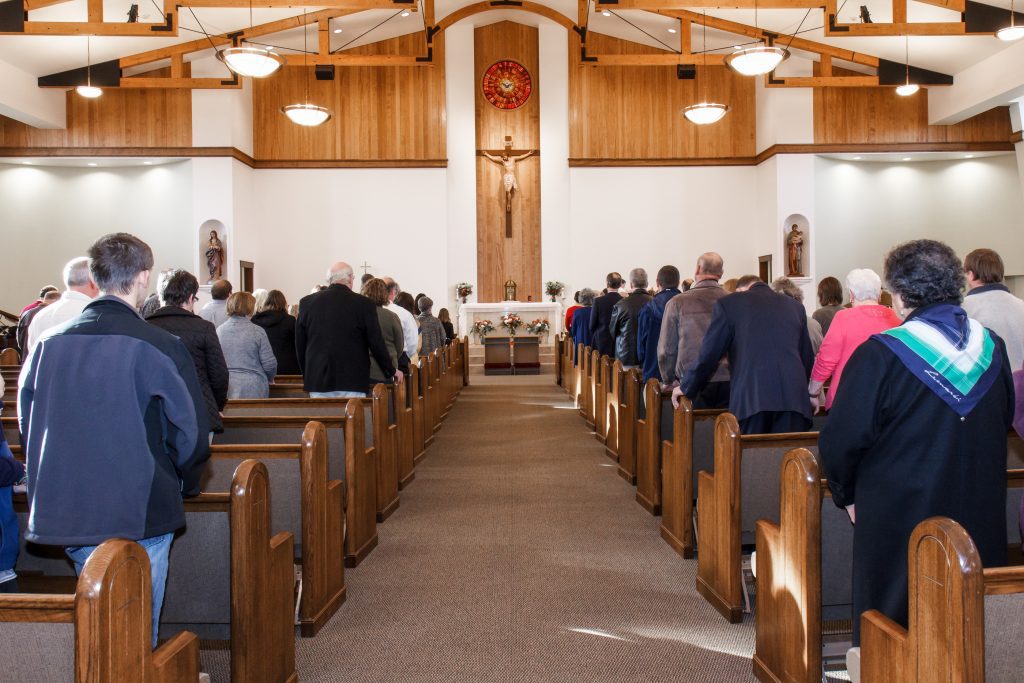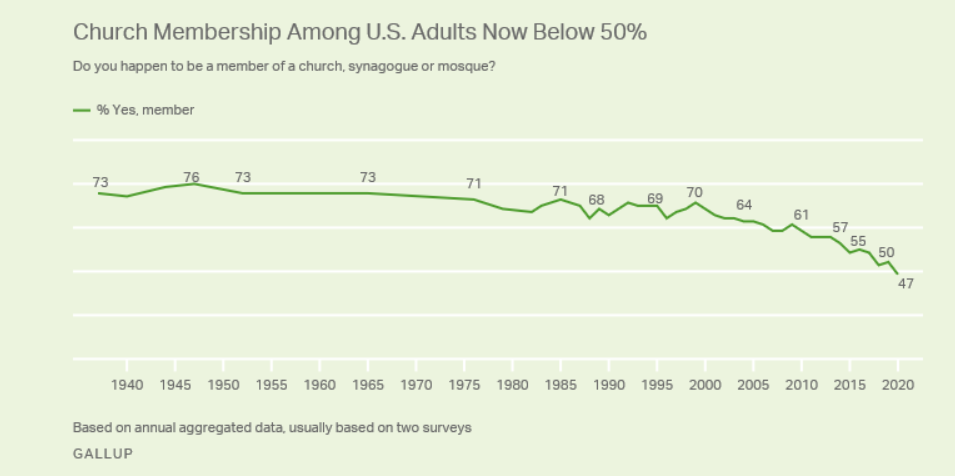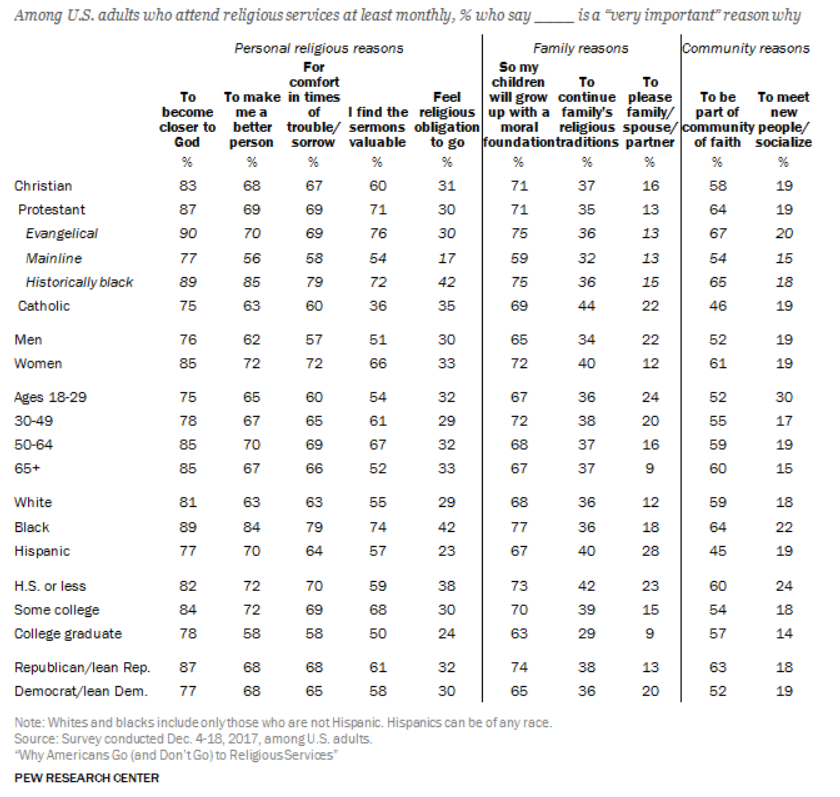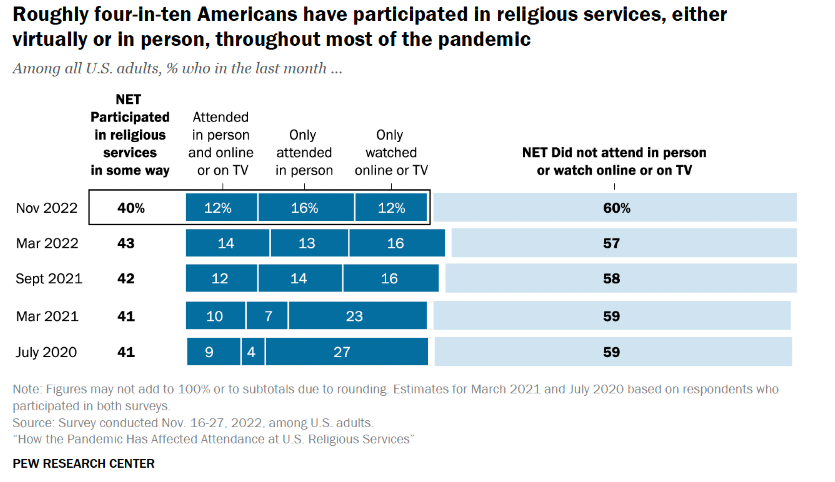Going to church is an important aspect for many religious people. That’s why we can learn a lot about the faith and practice of Americans by analyzing the church attendance statistics last 100 years.
Each aspect of life can impact the church attendance rates.
Let’s look at the latest numbers and find out why church attendance is declining by revealing the most important trends.

Top 10 Church Attendance Statistics
- 20% of Americans go to church at least once a week.
- Church membership has declined by over 26% in the last 83 years.
- 83% of Christians in America go to church to become closer to God.
- 37% of the Americans who don’t attend religious services use other ways to practice their faith.
- 28% of Americans don’t attend church because they don’t believe in God.
- 48% of US Protestant pastors say their church attendance is highest on Christmas Eve.
- 25% of churchgoers have invited someone to go to church with them three or more times.
- 48% of the respondents attended a religious service every week as a child.
- In the early stages of the COVID pandemic, one in three Christians in America stopped attending church.
- 20% of Americans attend church less often than before the pandemic.
General Church Attendance Statistics
1. 20% of Americans go to church at least once a week.
(Statista)
One in five respondents in a survey in 2022 said they go to church every week. The percentage of Americans attending church almost every week is twice lower, counting 10%. Also, only 11% go to church about once a month.
Unfortunately, the biggest percentage, 31% of Americans, said they never go to church. Furthermore, 26% of the respondents answered that they rarely go to church.
2. 9% of Americans go to church monthly.
(State of the Bible Report 2023)
The church attendance statistics 2023 show that less than one in ten Americans go to church monthly. Compared to the figures in 2022, the number of people attending church monthly increased by 1% in 2023.
However, the average church attendance per month in 2021 was slightly higher than in 2022 and 2023. In 2021, 10% of the respondents said they went to church at least once a month.
3. Church membership has declined by over 26% in the last 83 years.
(Gallup)
Gallup has been researching church membership among US adults since 1937. Their first measures for the church attendance statistics by year showed that 73% of US adults went to church.
Fast forward, US church membership has been rapidly declining since the late 1990s and early 2000s.
The average church membership between 1998 and 2000 was 69%. The latest data shows that the average number of US adults going to church from 2018 to 2020 fell to 49%.
More specifically, only 47% of US adults stated that they belong to a church.

4. 83% of Christians in America go to church to become closer to God.
Four in five Christians go to church to become closer to God.
Evangelical church attendance statistics show that 90% of evangelicals attend church to become closer to God. However, the numbers are slightly lower for mainline and historically black protestant traditions, of which 77% and 89% go to church for the same reason.
As for the Catholic church attendance statistics, 75% of Catholics responded that they went to church to feel personally closer to God in 2017.
Other most common reasons why Americans, regardless of their group, go to church are:
- To make themselves a better person – 68.5% on average
- Seeking comfort in hard times – 67% on average
- Finding the sermons valuable – 61.5% on average
- To raise their children with moral foundations – 70% on average

5. Most Protestants attend church mainly for sermons, while Catholics mostly go to church to connect religion to their life.
(Gallup)
A Gallup study from 2017 showed that there are differences between the motives for going to church.
83% of Protestants and other Christians go to church when there are sermons that teach about the scripture. The second reason why Protestants go to church is to find a connection between religion and their life.
On the other hand, Catholics mostly choose sermons that help connect religion to their life (67%), spiritual programs for children and teens (63%), and sermons that teach about the scripture (62%)
Other reasons why Protestant and Catholic churchgoers attend religious services are:
| Protestants | Catholics | |
| Volunteer opportunities and community outreach | 61% | 56% |
| Dynamic religious leaders | 53% | 47% |
| Social activities | 49% | 48% |
| Spiritual music, including choir | 44% | 29% |
6. 37% of the Americans who don’t attend religious services use other ways to practice their faith.
The latest church attendance statistics from 2017 show that four in ten Christians don’t attend church because they practice faith in other ways. Similarly, 37% don’t go to church because they dislike the institution.
On the other hand, 23% of people who don’t go to church stated that they haven’t found a church they like, and 7% don’t have one in their area.
Other reasons why the survey respondents who believe in God said they don’t go to church are:
- 18% don’t like the sermons
- 14% don’t feel welcome
- 22% don’t like the logistics
- 12% don’t have enough time
- 9% due to health reasons
7. 28% of Americans don’t attend church because they don’t believe in God.
38% of the survey respondents who don’t go to religious services are highly educated. Surprisingly, 75% of the respondents who rarely or never attend church are or lean toward the political beliefs of Democrats.
Additionally, most of them are male and typically younger generations.
8. 48% of US Protestant pastors say their church attendance is highest on Christmas Eve.
Almost half of the US Protestant pastors who were part of the LifeWay Research stated the church gathers the biggest number of believers on Christmas Eve.
However, 26% of the pastors shared that their churches welcome the most visitors in the third week of December. 10% picked the second week of December, while only 7% said the church attendance is highest on Christmas Day.
9. 25% of churchgoers have invited someone to go to church with them three or more times.
Every fifth respondent of the LifeWay survey said that they had invited someone to join them three or more times when they went to church. 21% asked someone to attend church with them twice, while 17% extended only one invitation.
On the contrary, 29% haven’t invited anyone.
There are significant differences between states in the US. For instance, 40% of the respondents located in the Northeast haven’t invited anyone. The numbers are lower in the Southeast and West, where 24% and 26% haven’t extended church invitations.
As for the responses to the church invitations, 37% of the invited Midwesterners refused to go.
The three main reasons why churchgoers don’t bring guests when they go to religious services are:
- 20% think they will be refused
- 17% don’t know who to invite
- 11% are not comfortable asking someone to go to church
10. Only 30% of the respondents in a 2022 survey have attended church in the last seven days.
(Gallup)
In a Gallup research, almost two in six Americans said they had attended a church or synagogue the week before the survey in 2022. The percentage of regular churchgoers has dropped 10% since 2012.
11. 48% of the respondents attended a religious service every week as a child.
(Gallup)
According to the last wave in August 2022 of the Gallup survey, 48% of the respondents went to a church, synagogue, or mosque when they were growing up. On the contrary, only 9% answered they never attended a religious service as kids.
Catholic Church Attendance Statistics
12. The weekly Catholic church attendance is the highest in Nigeria.
Nigeria has the highest Catholic Mass attendance, with 94% of the survey respondents going weekly or more than once a week.
According to the World Values Survey, the Catholic church attendance by country is the following:
- Kenya 73%
- Lebanon 69%
- Philippines 56%
- Colombia 54%
- Poland 52%
13. 39% of Catholics in America go to church at least once a week.
Two in five American Catholics attend religious services at least once a week. Similarly, 40% answered that they go to church once or twice a month or a few times a year.
Also, there are Catholics that rarely or never go to church. In the survey by Pew Research, they accounted for 20% of the Catholic respondents.
Demographic Church Attendance Statistics
14. Utah has the highest religious services attendance in the US, with 53% going at least once a week.
The states with the highest weekly attendance at religious services in the US are:
- Utah 53%
- Tennessee 51%
- Mississippi 49%
- South Carolina 47%
- Louisiana 46%
- West Virginia 46%
On the other hand, the states with the highest percentage of Americans not going to religious services are:
- New Hampshire 51%
- Vermont 47%
- Maine 47%
- Massachusetts 45%
- Washington 38%
15. 26% of women attend church weekly, compared to 22% of male believers.
The gap between the genders in church attendance has been narrowed down as fewer women attend church compared to the 1970s.
The latest data from 2012 shows that the gender gap is 6 points. In 1972 there was a 10-point gap when 36% of women and 26% of men attended church.
16. 48% of Americans above 65 attend religious services at least once a week.
Almost half of the respondents in the Pew Research survey above 65 years old stated that they attend religious services at least once a week.
The percentage is lower for other generations, with 38% of Americans aged between 50 and 64, 33% between 30 and 49 years old, and only 27% of young adults between 18 and 29 attend religious services weekly.
However, older Americans were not always the generation who attended church the most.

17. Generation X has recorded 12 points less church membership in the last two decades.
(Gallup)
Generation X has the biggest change in church membership between 1998 and 2020. Close to them are the traditionalists born before 1946, with 11 points drop, from 77% to 66%.
Baby boomers have shifted from 67% in the period between 1998 and 2000 to an average of 58% between 2018 and 2020.
18. Socioeconomic factors have a significant influence on religious commitment worldwide.
Why is church attendance declining?
Globally, worship attendance is influenced by different socioeconomic factors, including average life expectancy, education, GDP, and income equality.
The Pew Research survey noticed the following correlations between socioeconomic factors and church attendance:
- Countries with lower average life expectancy have a higher weekly worship attendance.
- The more time people attend school, the less often they go to church.
- The importance of religion is higher in countries with greater income inequality.
- Countries with a higher GDP typically have less religiously committed citizens.
COVID-19 Influence on Church Attendance Statistics
19. In the early stages of the COVID pandemic, one in three Christians in America stopped attending church.
(Barna)
According to data from Barna collected in the middle of 2020, 32% of the respondents stopped attending church because of the pandemic. However, the number of people who continued going to their church was 35%.
14% of the practicing Christians switched their pre-COVID church, while 18% attended different churches throughout the month.
20. The post-pandemic church attendance levels in 2022 declined by 3% compared to 2019.
Among all US adults, the church attendance levels recorded a 3% drop from 33% in 2019 to 30% in 2022.
The attendance rates by Christians and Catholics have reported a 6% and 4% drop, respectively.
The biggest church attendance changes have been among black Protestants, whose numbers declined from 61% in 2019 to 46% in 2022.
21. The highest rates of watching only online or TV sermons were the highest in 2020, counting 27%.
During the pandemic, Americans participated in religious services almost at the same rate, between 40% and 43%.
However, in 2020, most of them (27%) participated in worship services only virtually. During the same time, 9% attended in person and virtually, while only 4% went to church in person.
Slowly, the number of Americans who went back to church in person started to rise. The number was 14% in September 2021, 13% in March 2022, and finally 16% in November 2022.
The latest data from 2022 shows that 12% of Americans still watch only religious services online, while 12% tend to go to church in person in addition to participating in worship services virtually.

22. 9% of the Americans who attend church online said it is more convenient for their schedule.
(State of the Bible Report 2023)
Americans attend religious services online because it is more convenient for their schedule. Other reasons why online church is preferred among Americans are:
- Concerns about their health (7%)
- Enjoy the freedom and comfort of their home (7%)
- Fewer distractions and better concentration on the service (5%)
- Physical inability (3%)
- A more effective way to connect with God (3%)
- The church is far away (3%)
23. 20% of Americans attend church less often than before the pandemic.
One in five Americans answered that their church attendance is less frequent than before the pandemic. Yet, 31% haven’t changed their church habits, while 7% stated they go more often than before the pandemic hit.
Conclusion
The church attendance statistics have surely changed throughout the years, and will continue changing in the future. Following the latest trends is important to understand how strong the relationship of believers with religious organizations is.
Comparing the church attendance between different generations, we might have a slight decline in the number of people attending religious services. However, traditional religious institutions need to adapt and evolve if they want to attract new members.

 by
by 

